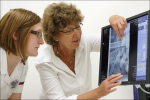


Theme
Simulators and Simulation
Category
Simulation
INSTITUTION
University of Portsmouth
Being able to learn and practice without risk to patients is one of the main reasons why learning in simulation is being adopted throughout healthcare education (Zigmont,et al., 2011, p.47). Kneebone et al. (2010, p.65) contend that learning from mistakes is a powerful educational experience and that simulation allows learners to achieve safe practice in an authentic environment which corresponds closely to the actual conditions of practice.
.jpg)
The themes that developed answered the research question that the students found learning within the SPE of benefit, and that these learning benefits in radiography, as in other health care professions, supports radiography students learning within the CPE.
An underlying theory emerged: that the learning befits within the SPE contributed to the professional socialisation of the students; giving them a platform of knowledge to support them in the transition into the clinical placement environment both in their initial and in subsequent placements. Learning in the SPE results in an increase in confidence that facilitates this transition, not only in cognitive skills but in engendering deeper underlying knowledge, this increased confidence provides the students with the ability to maximise their learning opportunities in placement.
.jpg)
The learning that the students engage with in simulation must support learning in the clinical environment whilst integrating with academic knowledge, and challenge students through increasing levels of difficulty (McGaghie, et al., 2010, p. 60). A model of learning was developed in a SPE to address this. This poster represents a dissertation in Teaching and Learning which explored students’ perceptions of this learning to facilitate their ability to maximise their learning opportunities in the clinical practice environment (CPE), within a BSc (Hons) Diagnostic Radiography degree.
.png)
The learning affordances in SPEs can prepare students to transfer effectively into CPEs.
If future radiography students are to be trained to meet standards outlined by their professional bodies, using learning in SPE’s could be essential. To be effective this must be central to the curriculum utilising current research in simulation education.
Providing an environment where the students feel safe and comfortable is an important area for consideration when designing learning programmes within SPEs.

Firstly I would like to say thank you to the amee organisers for giving me the opportunity to share this.
I would like to say a huge thank you to the students who gave their time freely in a content heavy course to participate in this research. Their enthusiasm and perception has been an inspiration.
I would also like to thank my colleagues at the University of Portsmouth for all their help and support.
Finally to my children, family and friends and last but not least to my husband, for his unfailing love, encouragement and kindness. I couldn’t have done this without you. Thank you!
Learning affordances offered within the SPE have been clearly identified. The results demonstrate the student’s perceptions of benefits in their preparation for placement, gaining cognitive skills, confidence and communication skills. The benefits of learning in a safe environment were recognised; learning within the SPE, provides the students with the freedom to ask questions and removes concerns over patient’s welfare.
 Send Email
Send Email